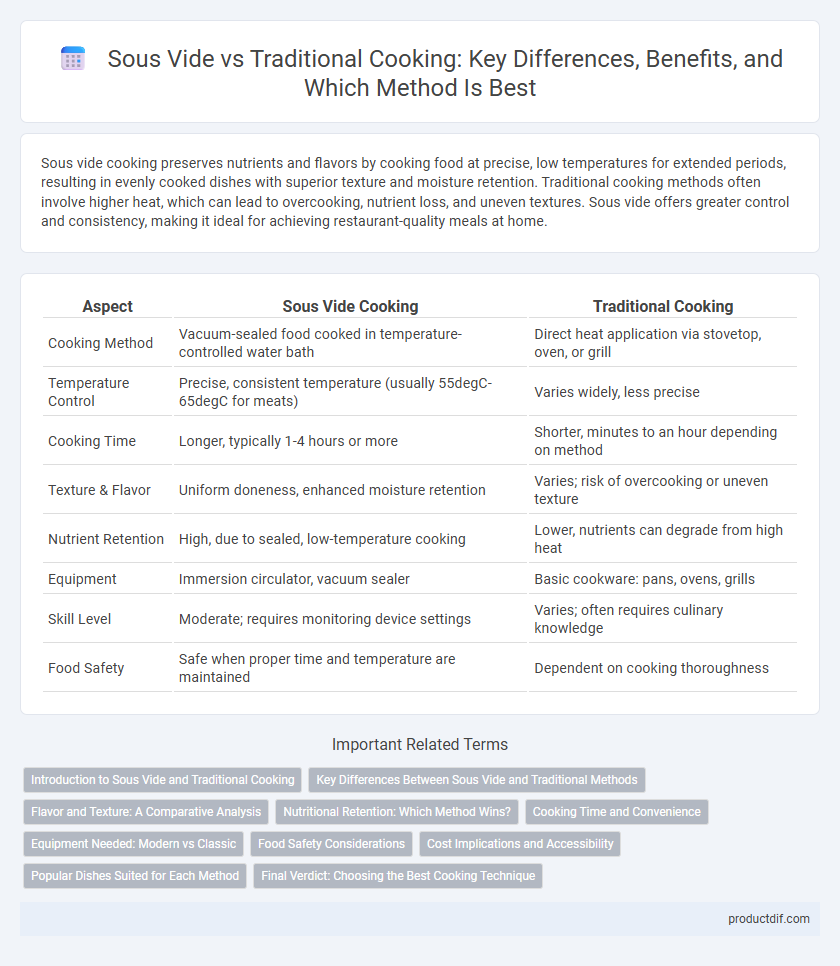Sous vide cooking preserves nutrients and flavors by cooking food at precise, low temperatures for extended periods, resulting in evenly cooked dishes with superior texture and moisture retention. Traditional cooking methods often involve higher heat, which can lead to overcooking, nutrient loss, and uneven textures. Sous vide offers greater control and consistency, making it ideal for achieving restaurant-quality meals at home.
Table of Comparison
| Aspect | Sous Vide Cooking | Traditional Cooking |
|---|---|---|
| Cooking Method | Vacuum-sealed food cooked in temperature-controlled water bath | Direct heat application via stovetop, oven, or grill |
| Temperature Control | Precise, consistent temperature (usually 55degC-65degC for meats) | Varies widely, less precise |
| Cooking Time | Longer, typically 1-4 hours or more | Shorter, minutes to an hour depending on method |
| Texture & Flavor | Uniform doneness, enhanced moisture retention | Varies; risk of overcooking or uneven texture |
| Nutrient Retention | High, due to sealed, low-temperature cooking | Lower, nutrients can degrade from high heat |
| Equipment | Immersion circulator, vacuum sealer | Basic cookware: pans, ovens, grills |
| Skill Level | Moderate; requires monitoring device settings | Varies; often requires culinary knowledge |
| Food Safety | Safe when proper time and temperature are maintained | Dependent on cooking thoroughness |
Introduction to Sous Vide and Traditional Cooking
Sous vide cooking involves vacuum-sealing food and cooking it in a precisely temperature-controlled water bath, ensuring even doneness and retaining moisture. Traditional cooking methods, such as grilling, roasting, or boiling, rely on direct heat and can result in uneven cooking and moisture loss. Sous vide offers precise temperature control for consistent texture and flavor, while traditional techniques provide more immediate results and varied textures through Maillard reactions.
Key Differences Between Sous Vide and Traditional Methods
Sous vide cooking uses precise temperature control to cook food evenly over extended periods, preserving moisture and enhancing flavor without overcooking. Traditional cooking methods apply direct heat, which can lead to uneven cooking and moisture loss due to higher temperatures and less control. The vacuum-sealed environment in sous vide prevents oxidation and infusion of flavors, unlike conventional techniques where exposure to air can diminish taste quality.
Flavor and Texture: A Comparative Analysis
Sous vide cooking enhances flavor and texture by cooking food evenly at precise low temperatures, preserving natural juices and intensifying taste profiles. Traditional cooking methods often lead to moisture loss and uneven heat distribution, resulting in less tender and less flavorful dishes. This comparative analysis highlights sous vide's ability to produce consistently tender textures and rich, robust flavors unattainable through conventional techniques.
Nutritional Retention: Which Method Wins?
Sous vide cooking preserves essential nutrients such as vitamins C and B by maintaining precise, lower temperatures and minimizing nutrient loss through sealed vacuum bags. Traditional cooking methods often expose food to higher heat and longer cooking times, resulting in greater degradation of heat-sensitive nutrients. Studies show sous vide can retain up to 30% more nutrients compared to boiling or roasting, making it superior for nutritional retention.
Cooking Time and Convenience
Sous vide cooking offers precise temperature control, resulting in consistent doneness and reduced risk of overcooking compared to traditional methods. While sous vide requires longer cooking times, often several hours to achieve tender results, it provides convenience through hands-off operation and the ability to prepare meals in advance. Traditional cooking methods typically have shorter cooking durations but demand constant attention and timing to prevent drying out or uneven cooking.
Equipment Needed: Modern vs Classic
Sous vide cooking requires specialized equipment such as an immersion circulator to precisely control water temperature and vacuum-sealed bags for food packaging, ensuring even cooking and enhanced flavors. Traditional cooking relies on classic tools like pots, pans, ovens, and stovetops, which offer broader versatility but less temperature precision. The modern sous vide setup emphasizes technology-driven accuracy, while traditional methods prioritize familiar and accessible kitchen essentials.
Food Safety Considerations
Sous vide cooking maintains precise temperature control between 130degF and 160degF, effectively killing harmful bacteria like Salmonella and Listeria while preserving food texture and flavor. Traditional cooking often exposes food to higher temperatures quickly, reducing microbial risks but increasing the chance of overcooking and nutrient loss. Ensuring proper vacuum sealing and time-temperature combinations in sous vide methods is critical to prevent anaerobic bacterial growth and guarantee food safety.
Cost Implications and Accessibility
Sous vide cooking requires specialized equipment like immersion circulators, which can represent a higher initial investment compared to traditional cooking tools such as pots and ovens that are widely available and often already owned. Operating costs for sous vide are relatively low due to precise temperature control and energy efficiency, while traditional methods may consume more energy and require constant attention, potentially increasing labor and utility expenses. Accessibility favors traditional cooking for most home cooks due to its simplicity and minimal equipment needs, whereas sous vide appeals to culinary enthusiasts willing to invest in the technology for consistent, restaurant-quality results.
Popular Dishes Suited for Each Method
Sous vide cooking excels with delicate proteins like salmon, chicken breast, and steak, offering precise temperature control for optimal texture and flavor retention. Traditional cooking methods shine with dishes requiring caramelization or crispy exteriors, such as roasted vegetables, pan-fried meats, and baked goods. Each technique highlights distinct culinary benefits suited for specific recipes, blending precision with classic textures.
Final Verdict: Choosing the Best Cooking Technique
Sous vide cooking delivers precise temperature control, ensuring consistent texture and enhanced flavor retention, making it ideal for delicate proteins and complex dishes. Traditional cooking offers versatility and faster preparation, suitable for everyday meals and achieving desirable browning effects. Choosing between sous vide and traditional methods depends on desired taste, texture, time availability, and equipment access.
Sous Vide vs Traditional Cooking Infographic

 productdif.com
productdif.com